
Seriously wealthy James Bond fans will be gathering at an auction house in London on Monday in the hope of making the winning bid for 007’s famous Lotus Esprit ‘submarine car’, affectionately known as Wet Nellie.
The car, which starred in the 1977 Bond movie The Spy Who Loved Me, is expected to fetch between £650,000 ($1m) and £950,000 ($1.48m) when it goes under the hammer today.
In the film, 007, played by Roger Moore, and Anya Amasova (Barbara Bach) escape the helicopter-flying baddies by driving the car off a pier into the sea. Of course, this being a Bond movie, we’re spared the sight of the secret agent and Amasova dying a horribly slow underwater death after Bond flips a switch that cleverly transforms the vehicle into a submarine.

Discovered in a storage container
Incredibly, the seller, who has decided to remain anonymous, found the car inside a storage container he bought on Long Island for just $100 in 1989. It’s not clear how it ended up there.
When he discovered the car inside the container, he reportedly had no idea that it was one of the most famous automobiles in movie history. Even when others brought the fact to his attention, he never had an inkling it would be worth anything. It was only when Doug Redenius, co-founder of the Ian Fleming Foundation, got in touch that he had the idea to sell it at auction.
Eight versions
According to Redenius, eight different versions of the car were used in the movie, including two for the chase and launch off the pier, and three for the underwater scene. It’s one of the underwater cars that’s being auctioned today. And yes, thanks to Florida-based marine engineering firm Perry Oceanographics, the car really does have submarine-like qualities, though the new owner might want to perform a few checks first if they have any plans to lob it back into the ocean. The other Lotus cars used in the movie are believed to be in a dilapidated state or housed in museums.
“Today, Wet Nellie is presented with its restored, museum display quality exterior, whilst inside, the full operational equipment appears to be complete and original,” RM Auctions says on its website. “This first-time-ever public offering of the Lotus is accompanied by copies of numerous period photos, rare movie stills, correspondence between Lotus East and the film production team, auto show memorabilia, and authentication documents.”
It adds, “The 007 Lotus Esprit Submarine Car is one of the most inspired creations in the history of filmmaking. As such, we wouldn’t want it to fall into enemy hands, so we invite those who can enthusiastically appreciate its technology, ingenious deployment, and legendary screen appearance to attentively consider this once-in-a-lifetime opportunity to acquire Wet Nellie, one of the most fascinating and entertaining movie vehicles of all time.”
[via NBC, RM Auctions]


